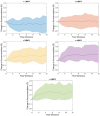Influence of power and the time of application of fogging lenses on accommodation
- PMID: 37854562
- PMCID: PMC10581808
- DOI: 10.1364/BOE.486442
Influence of power and the time of application of fogging lenses on accommodation
Abstract
Fogging is a non-invasive technique based on the use of positive spherical power lenses to relax accommodation during refraction that is commonly used as an alternative to cycloplegic drugs. Although the mechanism of the fogging technique has been described, some aspects of its methodology remain unclear. The main purpose of this work was to determine which lens power and time of application are more suitable for achieving a successful relaxation of accommodation by analyzing the changes in accommodation when fogging lenses of different powers were placed in front of the participants' eye for a certain timespan. The results of this analysis showed, in general, that low-power lenses and timespans of less than half a minute provided the highest relaxation of accommodation. However, high inter-subject variability was found in the two variables (power and time).
© 2023 Optica Publishing Group under the terms of the Optica Open Access Publishing Agreement.
Conflict of interest statement
The authors declare no conflicts of interest.
Figures






Similar articles
-
Peripheral refraction and higher-order aberrations with cycloplegia and fogging lenses using the BHVI-EyeMapper.J Optom. 2016 Jan-Mar;9(1):5-12. doi: 10.1016/j.optom.2015.06.003. Epub 2015 Jul 17. J Optom. 2016. PMID: 26190684 Free PMC article.
-
Principles and Technique of Fogging During Subjective Refraction.2023 Jul 19. In: StatPearls [Internet]. Treasure Island (FL): StatPearls Publishing; 2025 Jan–. 2023 Jul 19. In: StatPearls [Internet]. Treasure Island (FL): StatPearls Publishing; 2025 Jan–. PMID: 36251830 Free Books & Documents.
-
Influence of fogging lenses and cycloplegia on open-field automatic refraction.Ophthalmic Physiol Opt. 2008 Jul;28(4):387-92. doi: 10.1111/j.1475-1313.2008.00579.x. Ophthalmic Physiol Opt. 2008. PMID: 18565095
-
Accommodating intraocular lenses: a critical review of present and future concepts.Graefes Arch Clin Exp Ophthalmol. 2007 Apr;245(4):473-89. doi: 10.1007/s00417-006-0391-6. Epub 2006 Aug 30. Graefes Arch Clin Exp Ophthalmol. 2007. PMID: 16944188 Review.
-
Developments in the correction of presbyopia I: spectacle and contact lenses.Ophthalmic Physiol Opt. 2014 Jan;34(1):8-29. doi: 10.1111/opo.12091. Epub 2013 Nov 10. Ophthalmic Physiol Opt. 2014. PMID: 24205890 Review.
Cited by
-
A metric-based image-formation model explains the improvement in subjective refraction using temporal defocus waves.Optom Vis Sci. 2025 Apr 1;102(4):196-203. doi: 10.1097/OPX.0000000000002239. Epub 2025 Feb 25. Optom Vis Sci. 2025. PMID: 39999358 Free PMC article.
-
Comparing Close-Field and Open-Field Autorefractometry and Subjective Refraction.J Clin Med. 2025 Aug 11;14(16):5680. doi: 10.3390/jcm14165680. J Clin Med. 2025. PMID: 40869507 Free PMC article.
-
Pre-Cycloplegic Exam Benefit of Photoscreening and Accommodation-Relaxing Skiascopy.Clin Ophthalmol. 2024 Mar 15;18:833-846. doi: 10.2147/OPTH.S454430. eCollection 2024. Clin Ophthalmol. 2024. PMID: 38504935 Free PMC article.
References
-
- Benjamin W. J., Borish’s Clinical Refraction , 2nd ed. (Elsevier, 2006).
-
- Yeotikar N. S., Chandra Bakaraju R., Roopa Reddy P. S., Prasad K., “Cycloplegic refraction and non-cycloplegic refraction using contralateral fogging: a comparative study,” J. Mod. Opt. 54(9), 1317–1324 (2007).10.1080/09500340600855346 - DOI
LinkOut - more resources
Full Text Sources
